Stick welding is a popular type of welding that is a great choice if you’re welding outdoors in windy conditions. It’s pretty simple to learn, you can use it on rusty items, and you won’t need any gas. There are loads of stick welders on the market so we’ve picked our favorites and listed them below.
Contents
- Best Stick Welder Comparison Chart
- 1. DEKOPRO 160A ARC Welder
- 2. Amico Power Arc 160D
- 3. Hobart 500570 Stickmate 160i
- 4. Forney Easy Weld 180 ST
- 5. Miller Maxstar 161S
- 6. Forney Easy Weld 100ST Arc Welder
- 7. Longevity Stickweld 140
- 8. Everlast PowerARC 200ST
- 9. Everlast PowerARC 160STH
- 10. Miller Thunderbolt 160
- 11. Lincoln Electric K1170 AC225
- TIG Capability – Scratch Start vs Lift Start vs High Frequency (HF)
- Stick Welder Electrode Selection
- Things to consider when choosing a stick welder
Best Stick Welders
Click any of the links below to find which welder is best suited for your needs.
- Best stick welder for beginners
- Best 110V stick welder
- Best stick welder for portability
- Best stick welder for a budget
- Best stick welder for TIG
- Best stick welder/generator
Best Stick Welder Comparison Chart
Below is a comparison chart of the best Stick welders on the market.| Welder | Image | Amps 120/240V | Volts | TIG | Output 120/240V | Weight (lb) | Rating | Price | More |
|---|---|---|---|---|---|---|---|---|---|
| DEKOPRO 160A | 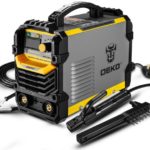 | 10-160 | Dual | Scratch Start | 60 @160A | 12.1 | 4.5/5 | $ | Review |
| Amico Power Arc 160D | 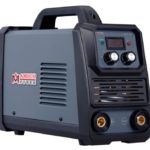 | 5-130A 5-160A | Dual | Lift start | 80% @130A 80% @160A | 16 | 4.4/5 | $ | Review |
| Hobart Stickmate 160i | 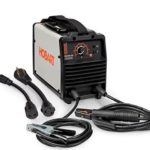 | 20–80A 20–160A | Dual | Scratch Start | 20% @65A 30% @160A | 15 | 4.4/5 | $$$ | Review |
| Forney Easy Weld 180 ST | 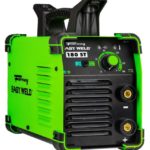 | 10-90A 10-180A | Dual | Lift Start | 30% @80A 25% @180A | 14 | 4.4/5 | $$$ | Review |
| Maxstar 161 S | 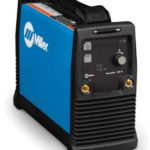 | 20-90A 20-160A | Dual | Lift Start | 30% @130A 20% @160A | 13 | 4.3/5 | $$$$$ | Review |
| Forney Easy Weld 100ST | 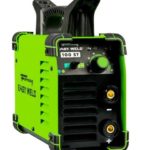 | 10-90A | 120V | Lift start | 30% @80A | 9.65 | 4.3/5 | $$ | Review |
| Longevity Stickweld 140 | 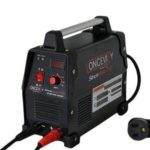 | 30-140 | Dual | Scratch Start | 60% @140A | 13 | 4.3/5 | $$ | Review |
| Everlast PowerARC 200ST | 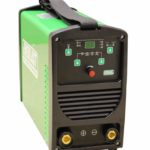 | 10-120A 10-200A | Dual | Lift Start | 35% @120A 35% @200A | 25 | 4.2/5 | $$$ | Review |
| Everlast PowerARC 160STH | 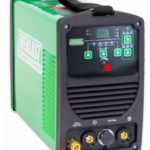 | 10-90A 10-160A | Dual | HF Start | 35% @90A 35% @160A | 25 | 4.2/5 | $$$$ | Review |
| Miller Thunderbolt 160DC | 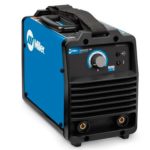 | 20-80A 20-160A | Dual | Scratch Start | 20% @65A 30% @160A | 15 | 4.2/5 | $$$$ | Review |
| Lincoln Electric AC225 | 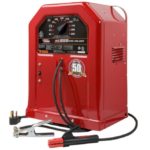 | 40-225A AC | 230V | No | 20% @225A | 109 | 4.0/5 | $$$ | Review |
1. DEKOPRO 160A ARC Welder
![]() Best all-round
Best all-round
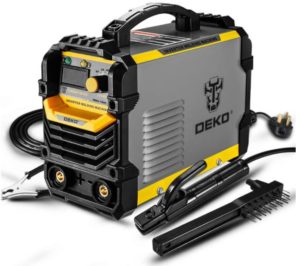 |
|
Our top pick for the best stick welder is the DEKPRO 160A. We couldn’t look past this due to its amazing value for money. It comes with a 220V plug and an adapter for 110V. It’s super portable at just 12 lbs with a handle on top. The stinger is decent quality and the leads are all a generous 10ft long. It will run all your standard electrodes with really impressive levels of performance for 6010, 6011, 6013, 7014, 7018 and 7024, especially on 220V. There’s a digital display on the front and the voltage can be continually adjusted and also a fan to cool the machine and thermal overload protection. This really is a top welder for the money, especially if you’re a hobby welder and want something that will do the job and help you get into stick welding with having to spend much money.
|
Specifications
|
Pros
Cons
|
2. Amico Power Arc 160D
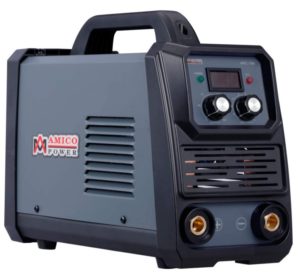 |
|
The Amico Power Arc 160 is another portable stick welder that’s available at a great price. The hot start and anti-stick functions help it lays good beads with 6010, 6011, 6013, 7014 and 7018, but can have difficulty starting on 6010 and 7018. This welder does have a lift start TIG function which is great if you’re thinking of using it for TIG as well (TIG torch sold separately). It’s a dual voltage machine with a power adapter so you can easily switch between power inputs. The 80% duty cycle at 160A allows for a generous welding time with a temperature activated cooling fan and thermal overload protection. If you’re looking for an all-round stick welder that’s portable, powerful, with decent performance at an affordable price, this stick welder ticks all the boxes.
|
Specifications
|
Pros
Cons
|
3. Hobart 500570 Stickmate 160i
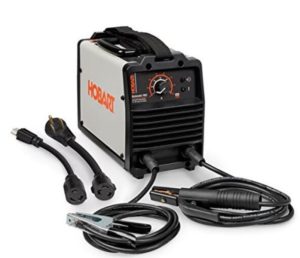 |
|
Hobart have created another really well built machine at an affordable price. This dual voltage stick unit holds really well with 6010 and 7018 3/32 electrodes on 110V and can weld 1/16–1/8″ on 110V and 1/16–5/32″ at 220V. The machine is Chinese made to Hobart’s specifications in the US which is why it’s cheaper than US made welders. This being said, Hobart’s quality standards have been proven time and time again over the years and this machine does not disappoint. It is more expensive than some of the cheaper Chinese manufactured welders, but it is covered by the Hobart 5/3/1 warranty and is a brand that has stood the test of time. Another great features is its portability. At just 15lbs and with a handle/shoulder strap it’s really easy to carry from job to job. It also features 120V/240V input power and 10ft cables. It’s the perfect stick welder if you’re looking for reliable performance and build quality at an affordable price.
|
Specifications
|
Pros
Cons
|
4. Forney Easy Weld 180 ST
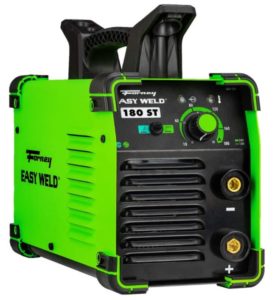 |
|
This is a great stick welder from Forney that’s the big brother to the 100ST. It can run all most standard electrodes pretty well and can run 1/8″ 6010 and 7018 on 120V but for best performance you’ll need to hook up to 220V. It will weld up to 1/2″ Mild Steel on 230V and 2/4″ Mild Steel on 120V. The arc strikes well and it has easy start technology to help minimize electrode sticking. Not only is this a versatile stick welder, it’s portable and has lift-start TIG so is well suited to TIG welding (TIG torch sold separately). The 8 foot cables aren’t as long as some other machines with 10ft cables, but it should be long enough especially due to the portability of the machine.
|
Specifications
|
Pros
Cons
|
5. Miller Maxstar 161S
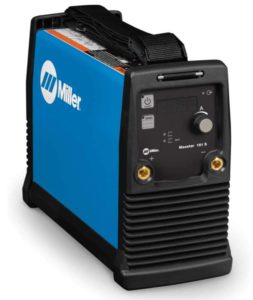 |
|
The Miller Maxstar 161S is a high-performance DC stick welder with excellent build quality. It’s very portable at just 13lbs but outputs up to 160A from 220V and 90A from 110V. Unlike the Thunderbolt 160, this has a digital display on the front for precise control and runs a lot nicer on 1/8″ 6010s and 7018s. It also has lift start TIG for better TIG performance, and a fan on demand with thermal overload protection to help prevent overheating. The main downside of a Miller unit is the price, quality like this doesn’t come cheap. Hobbyists on a budget might be better off looking at one of the cheaper Chinese manufactured units.
|
Specifications
|
Pros
Cons
|
6. Forney Easy Weld 100ST Arc Welder
![]() Best for lightweight and portability
Best for lightweight and portability
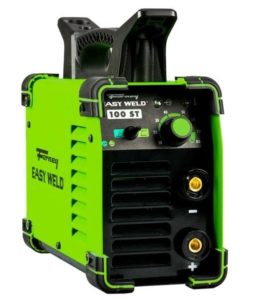 |
|
The Forney 100ST is a great stick welder for beginners who want something that’s easy to use and super portable. It’s a tiny machine that has a handle on top for carrying and weighs just 9.65lbs, making it the lightest stick welder in our top picks. It only runs off 120V so won’t give you much power, but it welds 16-Gauge up to 5/16″, so is a fine unit for doing little jobs around the garage. It’s best suited for 1/16″ electrodes but can handle up to 1/8″. The machine is well made and is a good quality unit. It’s not complicated to use at all and comes with a quick start guide to help get you up and running if you’re new to stick welding. It’s also capable of lift arc TIG and the TIG torch is sold separately.
|
Specifications
|
Pros
Cons
|
7. Longevity Stickweld 140
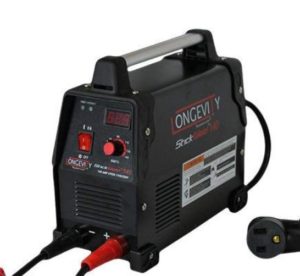 |
|
Longevity have made a stick welder that’s great for beginners. It’s easy to use with a digital display and nice buttons on the front. At just 13lbs it’s also one of the most lightweight stick welders, despite its ability to use 220 and 110V power supply. It has a good solid handle on the top for carrying it as well. It can start OK on 6010, 6011,6013, 7014 and 7018. Definitely a welder to consider if you can get it at a good price.
|
Specifications
|
Pros
Cons
|
8. Everlast PowerARC 200ST
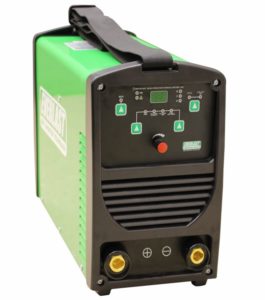 |
|
The Power200ST is welder that performs well on 6010, 7018, 7014, 7024, 6013 and 6011. It has a dedicated 6010 setting so all you need to do is activate it if you want to weld 6010 and you’re good to go. It has 10 foot leads and is dual voltage with maximum 3/16″ electrode on 240V and 1/8″ electrode on 120V. It has hot start and automatic arc control to help improve performance with less electrode sticking and a digital display for better precision. It doesn’t have HF TIG capability so you can’t connect a pedal to it, but it still has lift start TIG capability. It’s pretty portable at 25lbs but there are much lighter stick welders on the market. Finally, it comes with Everlast’s 5 year warranty to help protect your investment.
|
Specifications
|
Pros
Cons
|
9. Everlast PowerARC 160STH
![]() Best for TIG
Best for TIG
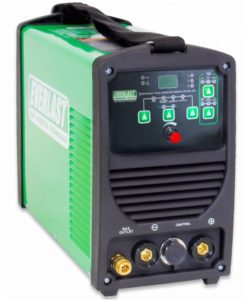 |
|
The PowerARC 160 is the only stick welder in our listing to feature HF TIG. It offers HF start for TIG or you can flight a switch to change to lift start if you don’t have a pedal, making this a great option for anyone thinking of TIG welding as well. There have been some question marks over the reliability of Everlast machines, however they’ve put forward a 5 year warranty on parts on labor, making this an attractive option. The 160 is dual voltage, but isn’t as portable as other DC inverter welders, weighing around 10lbs more. You should still be able to carry it, and it comes with a really nice carry case, but if portability is crucial then there are better options. It isn’t suitable for 6010s, but does perform well for 6013, 7014 and 7018. The arc runs smooth with auto arc control and is easy to start with hot start.
|
Specifications
|
Pros
Cons
|
10. Miller Thunderbolt 160
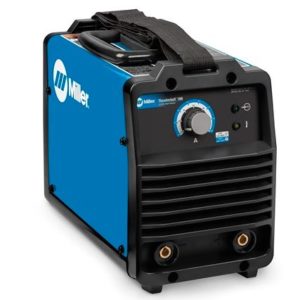 |
|
This is another pretty good little welder from Miller. It’s cheaper than the Maxstar, but doesn’t run well with 6010s and 7018s. It’s dual voltage with a multi-voltage plug for easy changeovers. It’ll weld up to 1/8″ on 120V and 3/8″ on 240V, however the duty cycle is quite low at 30% @ 160A. The Thunderbolt is portable, but the best thing about it as that once you get the arc started it lays great beads. It also has Hot Start technology to help arc starts. We do like this welder, but they are Chinese made (to US specifications) so it feels hard to justify the price.
|
Specifications
|
Pros
Cons
|
11. Lincoln Electric K1170 AC225
![]() Best AC stick welder
Best AC stick welder
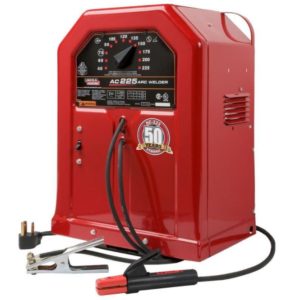 |
|
The American-made Lincoln Electric 225 is one of the best selling stick welders ever. It’s been built for decades in the USA and its design has stayed pretty similar. What this has going for it is that it’s stood the test of time, plenty of welders have had this machine for more than a decade with no problems. This is a transformer based AC unit, so you won’t have the luxury of welding DC, you can’t scratch start TIG and the machine is really heavy. However, it’s powerful at 40-225 amps, produces a really smooth arc for AC stick welding and the machine could well outlive you. Overall this is a solid stick welder but the price will probably seem a bit steep considering you can get a Chinese made highly portable DC stick unit for a lot cheaper.
|
Specifications
|
Pros
Cons
|
TIG Capability – Scratch Start vs Lift Start vs High Frequency (HF)
Scratch start
Any DC stick welder is capable of scratch start TIG welding with a TIG torch and Argon gas. AC machines cannot perform TIG. Scratch start is the least preferred method of TIG welding. To perform scratch start you need to set up your TIG torch and connect your gas. Then scratch the work piece with the electrode, similar to striking a match. Sometimes it starts the arc, sometimes bits of tungsten come off and stick to the metal. You only end the weld by pulling the torch away from the work piece and killing the arc.
Lift start
With lift start, you can initiate the arc much more successfully on steel than scratch start. If your welder has lift start capability, simply touch the metal you’re about to weld with the tungsten, then lift the tungsten to start the arc.
High Frequency
High frequency is the best option for TIG welding. HF initiates the arc for you. Get the tungsten close to the work piece metal, hit the foot control and the high frequency arc will initiate nice and smooth.
Stick Welder Electrode Selection
- 7018 electrodes are the most popular low hydrogen electrode. They provide low penetration but you’ll get a smooth arc with low spatter on DC. They can be used in any position and you can use a high travel speed. You need clean surfaces to run 7018s.
- 6010 electrodes are well suited for heavy industrial jobs. They provide deep penetration with high spatter. They are also suitable for use on rusty or unclean metal. They are used only in DC. Some stick welders struggle to run 6010s.
- 6011 electrodes have similar characteristics to 6010 electrodes but are suitable for AC welding. They’re suitable for rusty metal.
- 6013 is a versatile electrode that can be used for a lot of applications. It has light-medium penetration and can maintain an arc easily. You’ll need to clean the metal before welding.
- 7024 electrodes are not suitable for out-of-position welding due to the high levels of slag they produce. They are high deposition rod with a thick flux and low penetration. It leaves a smooth weld bead but requires a clean surface.
Things to consider when choosing a stick welder
Below are some of the factors to consider when choosing a stick welder. We’ve chosen our favorites based on a combination of these factors, however, read through these factors to help decide which one is best for you.
Input Voltage
Most welders either have an input voltage of 115V or 230V, with some welders having the capability to use both. These are known as dual-voltage welders. The 115V welders are best suited to hobbyists that aren’t looking for a great amount of power. You can plug these into your standard household power outlet which makes them versatile. 230V welders are more powerful, but you’ll need to have the correct power outlet. You’ll likely need to plug these into a generator to be able to use them.
Transformer or Inverter
Almost all the welders on our listings are DC inverter welders, not AC transformer welders. However, there are benefits to both that you should be aware of. Transformer machines will almost certainly outlive your inverter welder. They’re proven to stand the test of time and could last you decades. Meanwhile, DC interver welders with have electronic parts that will most likely fail in a few years. The main pro of an inverter welder is that they are so much lighter and more portable. This makes them much more appealing to most hobbyists.
Power Output
The amperage of the welder will give you an indication of the power you can get out of the machine. A higher amperage welder will mean deeper penetration and allow you to weld thicker metals. This will help speed up the welding process as you won’t need to perform multiple passes to achieve your weld. If you’re unsure of which amperage to go for then you’re better with a higher amperage welder. You can always turn the amps down on a powerful welder but you can’t turn them up on a low power welder.
Duty Cycle
Duty cycle refers to the period of time that you are able to weld before cooling down. If you want to stick weld for longer periods, then you will need to ensure you buy a welder with a high duty cycle. Duty cycle is displayed as a percentage, so 30% duty cycle will mean you can weld for 3 minutes before having a 7 minute cool down. The duty cycle will vary depending on your output power settings. The higher your amperage, the lower your duty cycle will be. Some stick welders have better duty cycles at set amperages than others, so pay attention to this when making your purchase.
Ease of Use
Ideally, on the front of a welder you want the controls to make it as easy as possible to use. Often you will have to pay more for advanced features such as auto-set, but most stick welders have basic settings that are easy to use. You should still make sure you can change the settings whilst wearing your gloves, and that you pick a welder with the controls that are best suited to your experience.
Portability
One of the main reasons people use stick welders is because of their versatility. You are able to use them in windy conditions and on different qualities of metal. If you’re buying a welder because you want to use it outdoors, then portability is a big consideration. Luckily, most stick welders are relatively light. If weight is a consideration, then you should choose an inverter welder over a transformer welder. Transformer welders are the old school style of welder that are many times heavier than an inverter. Stick welders are great because you can easily transport them to do odd jobs for clients, friends and family.
Safety
When using a welder you need to have safety features installed. If you get an old second hand welder, the chances are it won’t be safe to use and you’ll be putting your safety at risk. Thermal overload protection is a must have on welders. This automatically turns off the welder before overheating. This is great because you can weld without worrying that you’re going to exceed your duty cycle. You should still, however, keep an eye on the duty cycle indicator to prevent you from activating the overload protection. You should always read the safety manuals of any welding equipment you’re using, wear the correct gear, and don’t take any chances!
Price
Stick welders are some of the cheapest welders you can buy so they’re a good choice if you have a low budget. Multi-process stick welders are much more expensive than single process, but could save you money in the long run as you won’t need to buy a different welder for each welding process you wish to perform.
We hope you liked our article “The Best Stick Welders in 2022” if so, we’d really appreciate it if you could rate and share it.

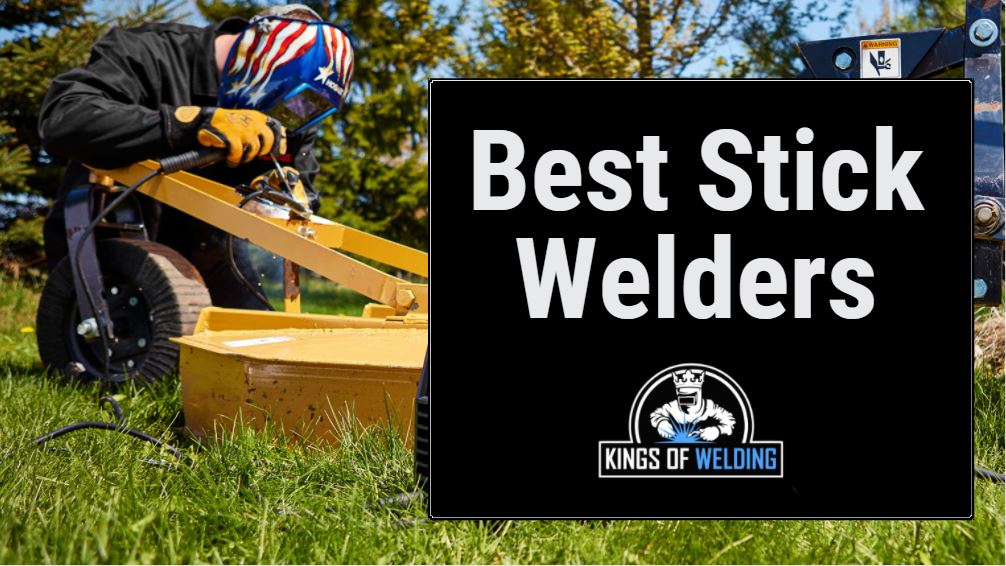
 (5.0 / 5)
(5.0 / 5) (4.0 / 5)
(4.0 / 5) (4.5 / 5)
(4.5 / 5) (4.4 / 5)
(4.4 / 5) (2.5 / 5)
(2.5 / 5) (4.3 / 5)
(4.3 / 5) (3.5 / 5)
(3.5 / 5) (4.2 / 5)
(4.2 / 5) (3 / 5)
(3 / 5)
Hi do I need to remove rust before welding with the Amico Power ARC?
Hi David,
Thanks for commenting – You don’t need to remove rust for stick welding like you do with MIG, but it doesn’t harm to give it a bit of a clean if you can before laying a stick weld.
Thanks,
John